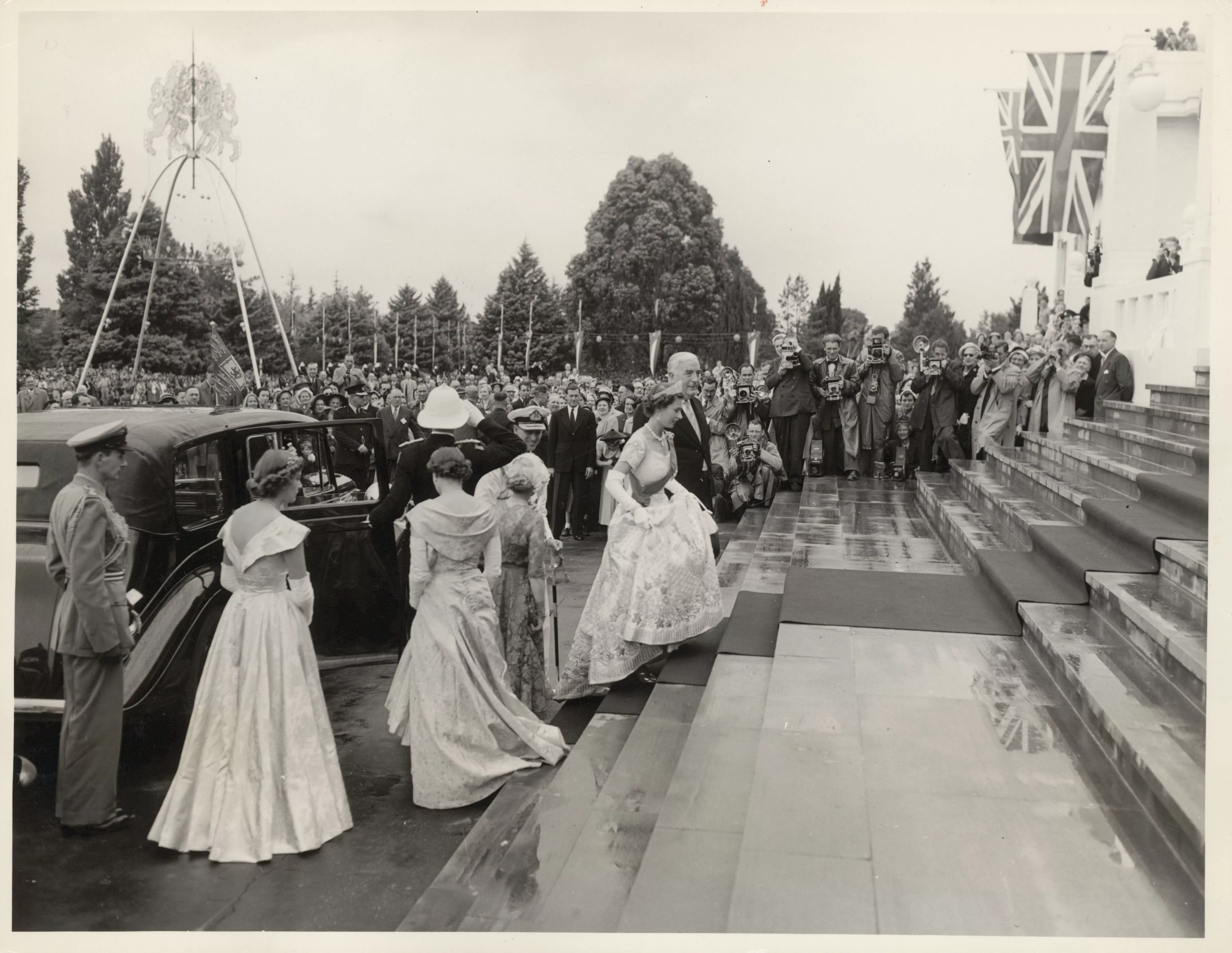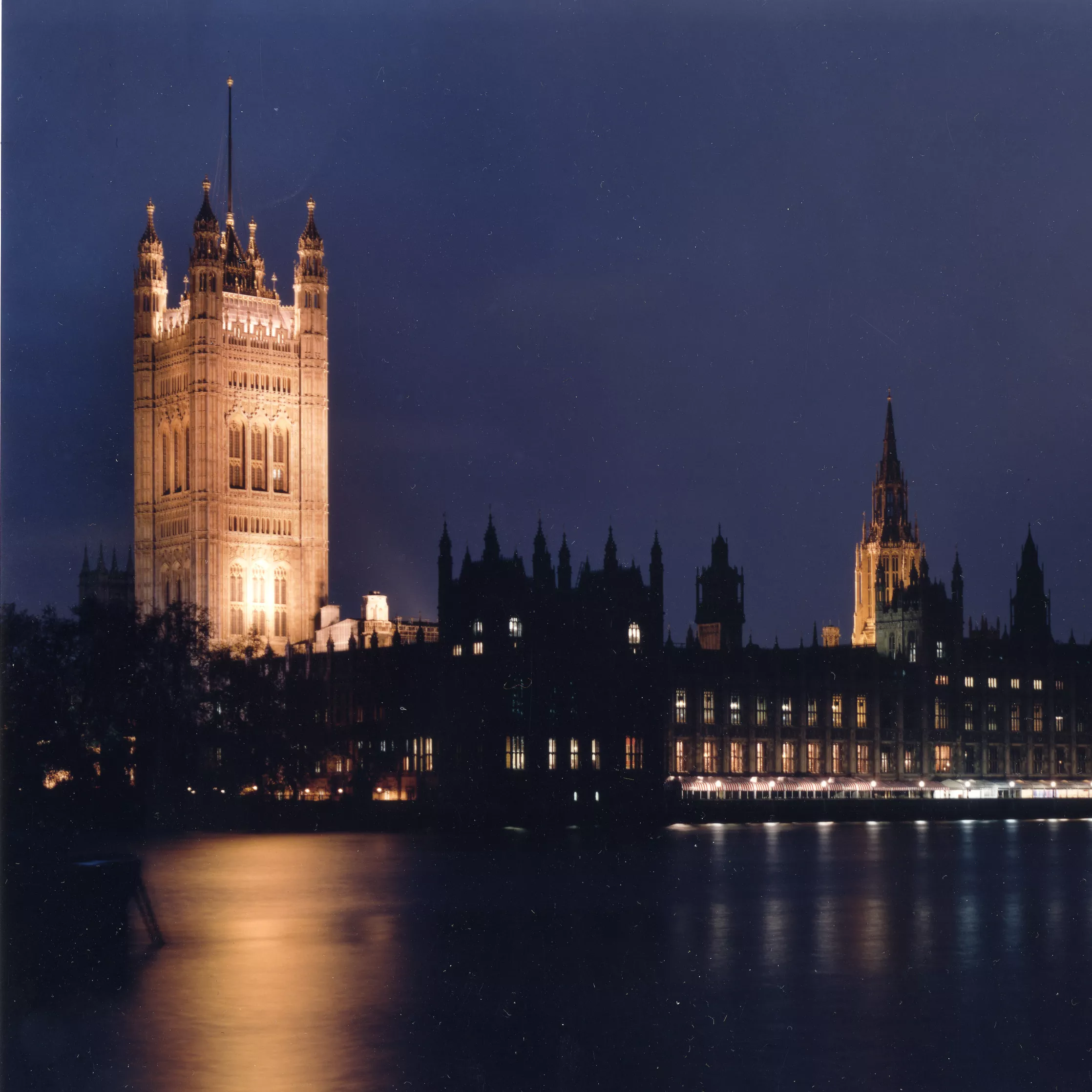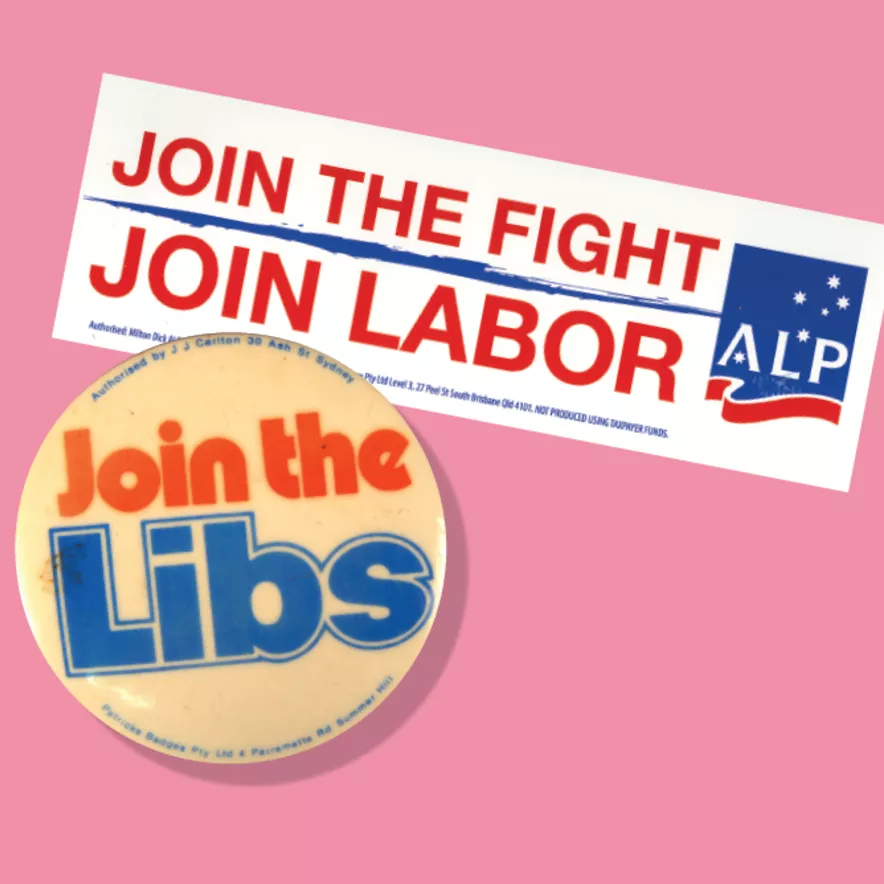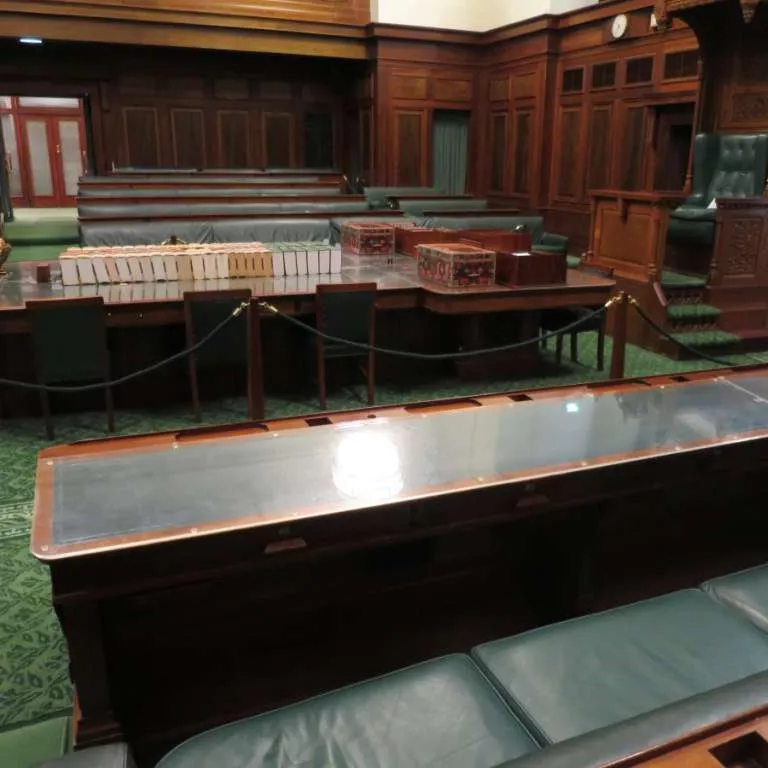Remembering Elizabeth II in the halls of Old Parliament House
- DateFri, 09 Sep 2022
The life and reign of Elizabeth II is closely connected to the history of Old Parliament House.
In 1927 and just a year after her birth, the building was opened by her parents, then the Duke and Duchess of York and, from 1954 to 1986, Elizabeth II visited Old Parliament House on nine occasions. Each visit gives us an insight into the monarch’s relationship with a changing Australia.
1954 – A damp but heartfelt tableau
Princess Elizabeth first planned to visit Canberra in 1952 as part of a world tour including Kenya, Ceylon and New Zealand. Fate intervened with the death of her father, King George VI, and she travelled home from Kenya as Queen. The world tour was postponed until late 1953.
The Queen arrived in Canberra on 15 February 1954 and opened a new session of the Commonwealth Parliament. Resplendent in her Coronation gown, the front page of The Canberra Times reported that the Queen ‘brought sparkling beauty to the Senate Chamber’ while torrential rain doused a crowd of 30,000 well-wishers. Thousands of children, soaked to the skin, waited in anticipation at the front of Parliament House to hold aloft coloured squares to spell out ‘Our Queen’ for her arrival. Alas, the signal came 10 seconds too late and the Queen had already entered the building. In compensation, they performed their bedraggled tableau six times for an appreciative crowd.
The Queen’s arrival in the Senate chamber was announced by the Usher of the Black Rod, J R Odgers, later a legendary Clerk of the Senate. After reading her speech, in which she noted that section 1 of the Constitution made her a part of the Parliament, the Queen reviewed a parade of 4500 members of the armed forces from the steps of Parliament House. Units of the Pacific Islands Regiment and the Royal Papuan and New Guinea Constabulary were suitably attired for the weather, marching through the puddles in sandals.
The climax of the Queen’s 1954 visit to Canberra was the glittering State Ball held at Parliament House. The women wore ball gowns, long gloves and diamond and pearl tiaras and men sported white tie and tails. The Brazilian Ambassador was a fashion stand out in ‘gold-braided green tails and white trousers’. The guests danced in a King’s Hall transformed into a ‘ballroom of floral beauty’ and sipped champagne under the trees in the House of Representatives Courtyard. According to The Canberra Times, the supper was ‘reminiscent of an ancient feast’ with boars’ heads, stuffed suckling pig, lobsters, pheasant, crayfish and oysters to tempt the taste buds, along with a towering centrepiece featuring the Australian coat-of-arms crafted from sugar and marzipan. The poor Queen had no opportunity to dance, being presented to a long line of the great and the good.
1963 – I did but see her
The Queen returned to Canberra, again in pelting rain, on 18 February 1963 for the 50th anniversary of Canberra’s founding. The local paper reported that cheers for the Queen’s arrival were ‘mixed with shouts from official guests to lower umbrellas which obscured the views of most’. At least it was dry in King’s Hall which was the setting for a ‘gay and colourful’ State reception. In his welcoming speech, Prime Minister Robert Menzies asked the Queen to ‘remember in this country of yours that every man, woman and child who sees you will remember it with joy – remember it in the words of that 17th century poet who wrote these lines, "I did but see her passing by and yet I’ll love her till I die".’
1970 – Grouse and gold lame
Canberra again rained on the Queen’s parade when she returned in April 1970 during a royal tour celebrating the bicentenary of Captain James Cook’s charting of Australia’s east coast. King’s Hall was filled with flowers for an evening reception. Member of Parliament Al Grassby, renowned for his colourful ties, cut a startling figure ‘in a patterned gold lamé dinner jacket’. The menu included grouse and pheasant ‘with champagne in abundance’. Empire lived on through food, drink and costume.
1973 – Just call me Queen of Australia
By 1973, the political landscape had changed. Gough Whitlam’s Labor Government had a nationalistic agenda, including a change to the Queen’s ‘royal style and titles’. Two decades prior, under the Menzies Government, the Commonwealth Parliament had enacted legislation to which the Queen personally gave her royal assent conferring upon her the title ‘Elizabeth the Second, by the Grace of God of the United Kingdom, Australia and Her other Realms and Territories Queen, Head of the Commonwealth, Defender of the Faith’. Whitlam wanted to remove the references to ‘by the Grace of God’, the ‘United Kingdom’, ‘Defender of the Faith’ and ‘the Second’ (as there had never been a previous Queen Elizabeth of Australia). Correspondence held in the National Archives of the United Kingdom and the National Archives of Australia reveals that the Queen agreed to drop the references to the United Kingdom and Defender of the Faith. She insisted, however, on keeping ‘by the Grace of God’, as it was personally important, and the reference to ‘the Second’, because of political issues concerning Scotland. The Queen also indicated that she wanted to give her personal assent to the Bill that would enact the changes, and make the resulting proclamation.
The Queen made the formal proclamation during her visit to Australia in 1973 to open the Sydney Opera House. Her new title was ‘Elizabeth the Second, by the Grace of God Queen of Australia and Her other Realms and Territories, Head of the Commonwealth’ and, on 18 October at an official luncheon at Parliament House, the loyal toast by Prime Minister Whitlam referred to the ‘Queen of Australia’ for the first time. Whitlam was jumping the gun because the Queen did not formally proclaim her new title until the following day, but it reflected the government’s impatience for change. The Queen also undertook other formal duties as head of state, such as swearing in the new Minister for the Northern Territory, signing the credentials of Australia’s Ambassadors to Japan, the Soviet Union and the United States, and ratifying a border treaty with Indonesia.

Pastry chef Arthur Mueller shows off the centrepiece created for the supper at the State Ball. Credit: Tony Scarth / MoAD collection.
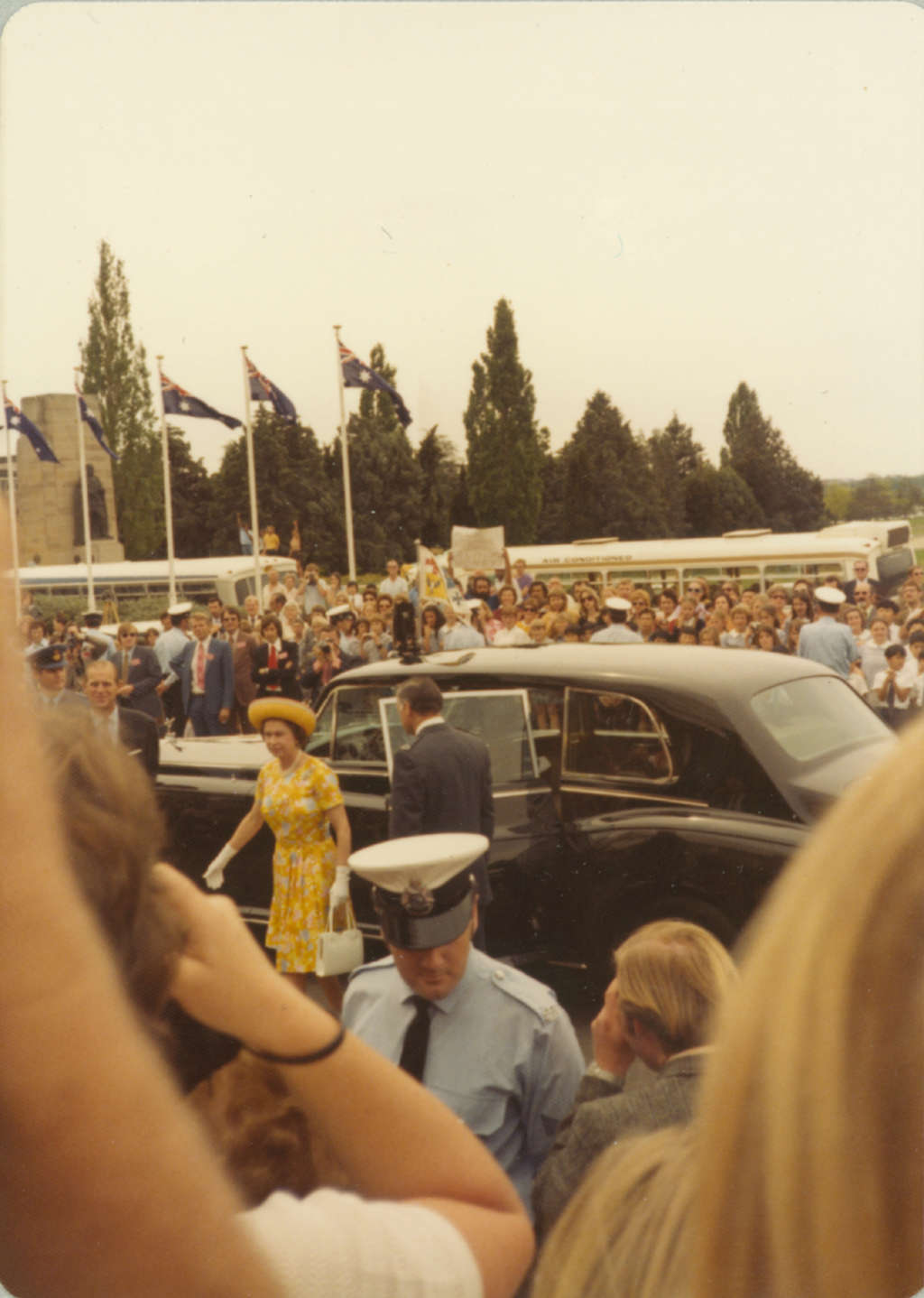
Members of the public and protesters witness the arrival of the Queen in October 1973 for luncheon and a speech. Credit: Christina Motz / MoAD collection.

The Queen and Prince Philip review the defence forces and acknowledge the crowds in front of Parliament House in 1977. Credit: Fairfax Syndication.
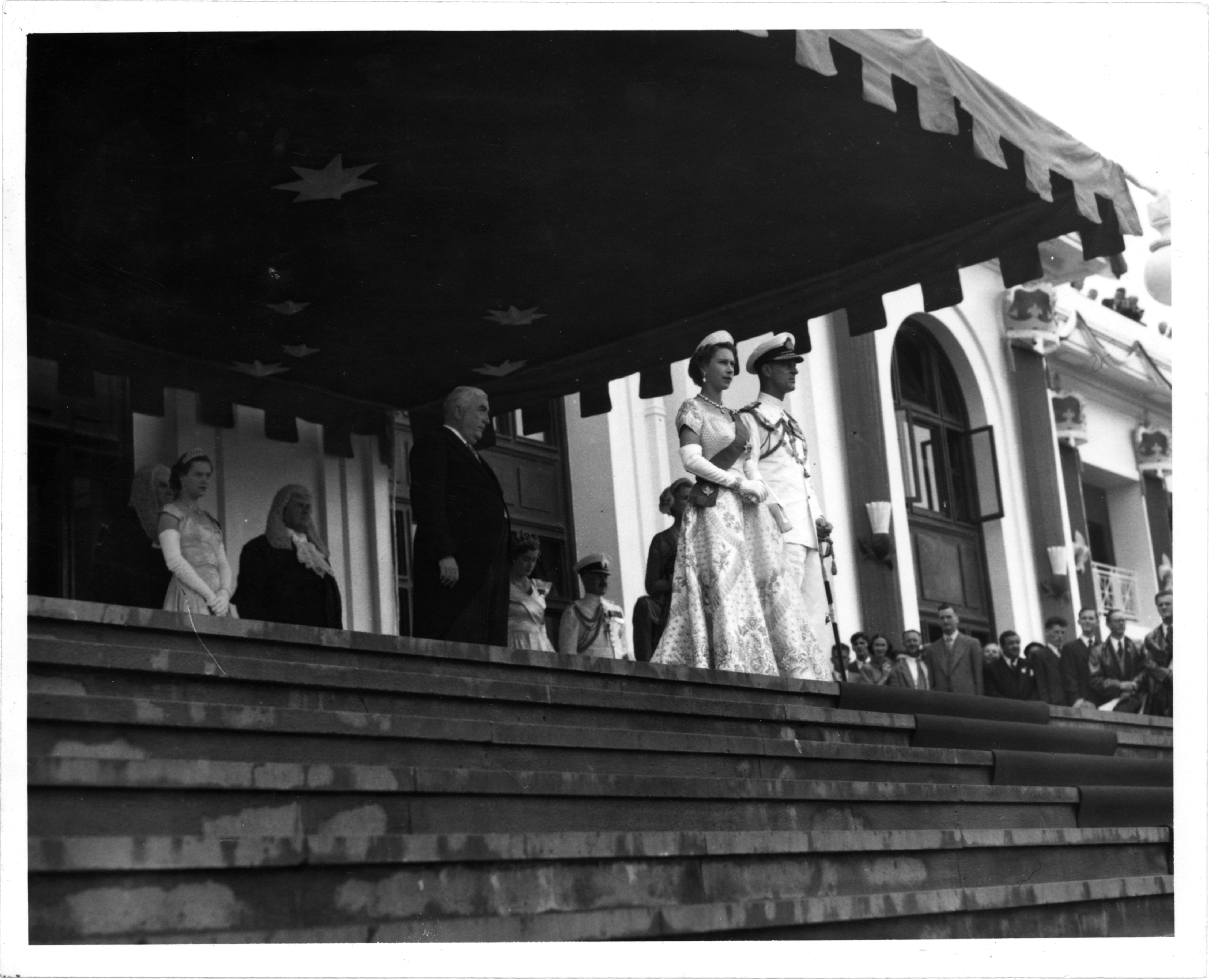
Queen Elizabeth, in her coronation dress, and Prince Philip on the front steps of Old Parliament House. Standing close behind is PM Robert Menzies. Credit: MoAD collection.
1974 – Protests and priorities
Less than six months later, the Queen was back in Australia and opened Parliament on 28 February. Noisy protests outside the building on land rights and rejection of Imperialism marked the changing times. According to The Canberra Times, the Queen was ‘jeered, booed and called names’ by Aboriginal demonstrators and banners demanded ‘British imperialists out’ and ‘Solidarity with blacks of Australia’.
The Queen’s speech in the Senate Chamber set out the Whitlam Government’s ambitious program, including plans to abolish appeals to the Privy Council. While it is well recognised that the ‘Queen’s Speech’ at the opening of Parliament is in fact the speech of her government, on this occasion the Queen required it to be altered. The Whitlam Government had sought to convey the impression that the Queen had accepted its advice that it alone could advise her in relation to matters concerning the States of Australia, whereas in fact the Queen still acted upon the advice of her British ministers concerning State matters. The Queen’s Private Secretary, Sir Martin Charteris, insisted that ‘for the sake of truth’ the speech be altered to record that the Queen had been advised by British ministers in relation to State matters and by Australian federal ministers in relation to those matters concerning the federal government. The final version stated that she had acted upon the advice of both her Australian and United Kingdom ministers.
The Queen cut short her 1974 Australian tour immediately after opening Parliament. A general election had been held in the United Kingdom and the Counsellors of State, who perform the Queen’s formal duties in her absence, do not have the power to commission a prime minister. Her constitutional function as Queen of the United Kingdom took priority and Prince Philip stayed in Australia to complete the tour.
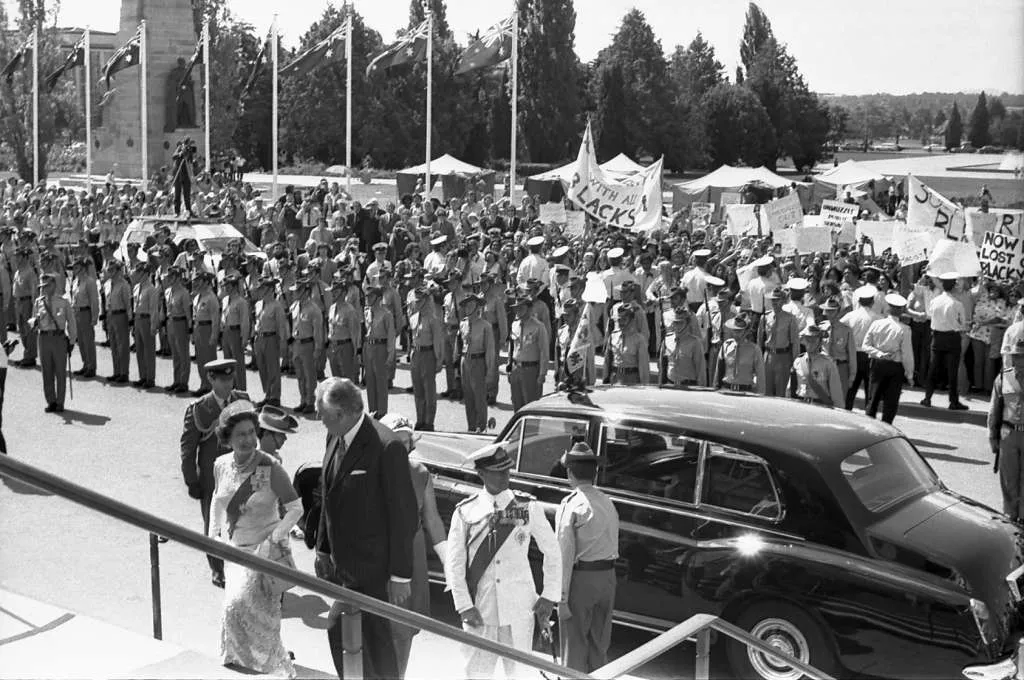
Arriving to open parliament in the summer heat of 1974, the Queen was escorted up the steps by Prime Minister Gough Whitlam. - Ted Golding/Fairfax Syndication
1977 – A kilted Snedden in a changing empire
On her Silver Jubilee tour in 1977, the Queen opened Parliament for the third time, on 8 March. On this occasion, the military parade in front of Parliament House was not marred by rain. About 100 protesters from the ‘New Independence movement’ waved Eureka flags, but their chants were drowned out by the cheering crowd. They did, however, win a ‘broad smile and wave’ from Prince Philip, but the Queen looked straight ahead as she passed by.
The Queen also held a Privy Council meeting and an investiture of honours. At the welcome reception the Speaker of the House, Billy Snedden, attracted attention dressed in a kilt, blue velvet jacket and lace cravat. Prime Minister Malcolm Fraser spoke of Australia’s gift to the Queen of a racehorse, while former Prime Minister Whitlam mused that one of the Queen’s predecessors ‘would have given his kingdom for a horse’. Whitlam also noted that the Queen ‘had acted to give independence and nationhood to more millions than any monarch in history’, reflecting on the gradual dismantling and decolonisation of the Empire and the creation of independent states, some of which became republics while others became Realms with the Queen remaining as head of state.
1980 and 1982 – Modern times
On 26 May 1980 the Queen visited Canberra to open the new High Court of Australia building, returning within 18 months on 12 October 1982 to open the adjacent Australian National Gallery. Receptions were held at Parliament House on both occasions but the focus was on the modern architecture of these iconic buildings. Their cost did not go unnoticed. The Canberra Times reported that protesters outside the High Court waved placards saying ‘we demand a refund’ and ‘welfare not fanfare’.
1986 – The big deal
Australia finally broke off constitutional links with the United Kingdom through the enactment in both the United Kingdom and Australia of the Australia Acts in 1986. The Queen had resisted this legislation. Amongst other things, it permitted her to be advised directly by State Premiers, instead of British ministers, on State matters. She was concerned about receiving ‘outlandish’ or conflicting advice from her various Australian governments. With great reluctance and under pressure from the combined Australian governments, she finally agreed with the proviso that when visiting Australia she would ‘only do what she wants to do’ and could refuse to act upon advice to which she objected.
On 2 March 1986, the Queen signed the proclamation to bring into force the Australian version of the Australia Acts in the drawing room of Government House in Canberra. As nervous ministers stood in a semi-circle to be introduced to the royal couple, Gareth Evans found himself in an awkward conversational pause with Prince Philip. He filled the silence by proudly explaining that, as Attorney-General, he had put a lot of work into negotiating this fundamental constitutional change and how pleased he was that it had finally come to fruition. Prince Philip rapidly brought him down to earth with the two-word reply, ‘Big deal.’ But it was a big deal. When the Australia Acts came into force the following day at 4pm, two centuries of constitutional ties between the United Kingdom and Australia ended. The only remaining tie was the Queen.
That evening the Queen attended a final reception at Parliament House. With the building scheduled for closure in 1988, this would be her final visit. When she first ascended the front steps in 1954, Menzies was Prime Minister, Britain was ‘home’, women wore gloves and tiaras to the reception and the British Government still advised the Queen on matters such as the appointment of Australian State Governors and assent to reserved State bills. On the evening of 3 March 1986, as she ascended the steps of Parliament House for the last time, the sun had set on the British Empire. She was there as Australia’s Queen and no other.


